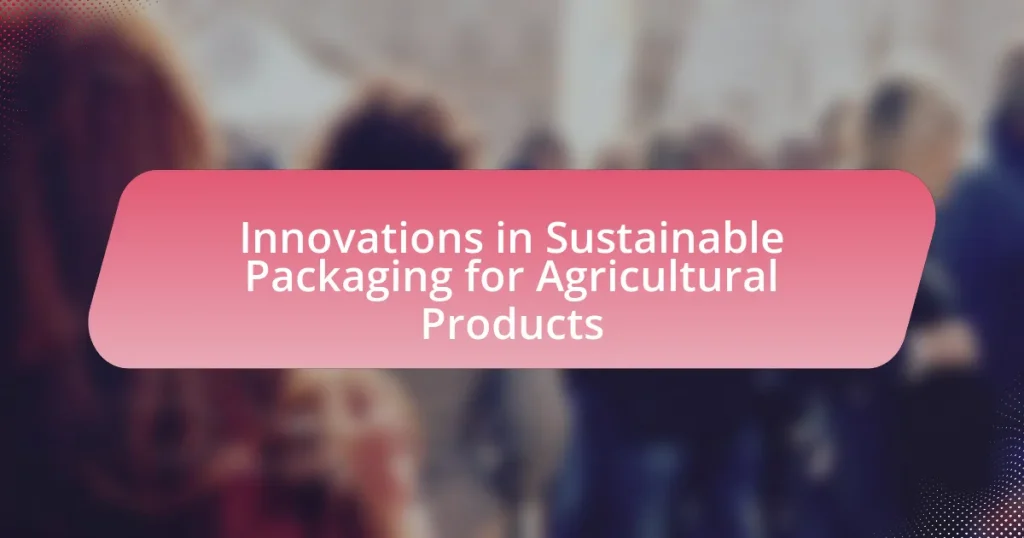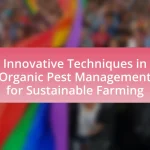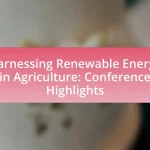Innovations in sustainable packaging for agricultural products focus on reducing environmental impact through the use of biodegradable materials, reusable containers, and smart packaging technologies. These advancements aim to minimize waste, enhance product freshness, and improve supply chain efficiency, ultimately contributing to a lower carbon footprint. Key features include biodegradability, recyclability, and the use of renewable resources, which collectively address the environmental challenges posed by traditional packaging methods. The article also explores the implementation of these innovations in the agricultural sector, the challenges faced, and successful case studies that highlight the benefits of adopting sustainable packaging practices.

What are Innovations in Sustainable Packaging for Agricultural Products?
Innovations in sustainable packaging for agricultural products include biodegradable materials, reusable containers, and smart packaging technologies. Biodegradable materials, such as plant-based plastics and compostable films, reduce environmental impact by breaking down naturally after use. Reusable containers, like glass jars and metal tins, promote a circular economy by allowing multiple uses, thus minimizing waste. Smart packaging technologies, which incorporate sensors and indicators, enhance product freshness and reduce spoilage, leading to less food waste. These innovations are supported by research indicating that sustainable packaging can significantly lower carbon footprints and improve supply chain efficiency.
How do these innovations impact the agricultural industry?
Innovations in sustainable packaging significantly enhance the agricultural industry by reducing waste and improving product shelf life. These advancements, such as biodegradable materials and smart packaging technologies, minimize environmental impact while ensuring that agricultural products remain fresh during transportation and storage. For instance, the use of biodegradable films can decrease plastic waste by up to 50%, as reported by the European Bioplastics Association. Additionally, smart packaging solutions that monitor temperature and humidity can extend the freshness of produce, leading to reduced spoilage rates, which currently account for approximately 30% of food waste globally.
What are the key features of sustainable packaging innovations?
Key features of sustainable packaging innovations include biodegradability, recyclability, reduced carbon footprint, and the use of renewable materials. Biodegradable packaging decomposes naturally, minimizing environmental impact, while recyclable packaging can be processed and reused, reducing waste. Innovations often focus on materials like plant-based plastics or paper alternatives, which significantly lower carbon emissions during production. For instance, a study by the Ellen MacArthur Foundation highlights that shifting to biodegradable materials can reduce plastic pollution by up to 80%. These features collectively contribute to a more sustainable approach in packaging, particularly for agricultural products.
How do these features contribute to environmental sustainability?
Innovations in sustainable packaging for agricultural products contribute to environmental sustainability by reducing waste and minimizing resource consumption. These features often include biodegradable materials, which decompose naturally and lessen landfill accumulation, and recyclable designs that promote circular economy practices. For instance, using plant-based plastics can reduce reliance on fossil fuels, as these materials are derived from renewable resources. Additionally, lightweight packaging reduces transportation emissions, as less energy is required to move products. According to a study by the Ellen MacArthur Foundation, transitioning to sustainable packaging could reduce greenhouse gas emissions by up to 70% in the packaging sector by 2040.
Why is sustainable packaging important for agricultural products?
Sustainable packaging is important for agricultural products because it reduces environmental impact and enhances product safety. By utilizing biodegradable or recyclable materials, sustainable packaging minimizes waste and pollution associated with traditional packaging methods. For instance, according to a study published in the Journal of Cleaner Production, using biodegradable packaging can reduce plastic waste by up to 50%, significantly lowering the carbon footprint of agricultural supply chains. Additionally, sustainable packaging often improves shelf life and preserves the quality of agricultural products, which is crucial for maintaining food safety and reducing spoilage.
What environmental challenges does traditional packaging pose?
Traditional packaging poses significant environmental challenges, primarily due to its reliance on non-biodegradable materials such as plastics and polystyrene. These materials contribute to pollution, as they can take hundreds of years to decompose, leading to increased landfill waste and ocean contamination. According to the United Nations, approximately 300 million tons of plastic are produced annually, with a substantial portion ending up in the environment, harming wildlife and ecosystems. Additionally, traditional packaging often involves high energy consumption during production and transportation, further exacerbating carbon emissions and climate change.
How does sustainable packaging address these challenges?
Sustainable packaging addresses challenges in agricultural product distribution by reducing environmental impact and enhancing product preservation. It utilizes biodegradable materials, which minimize waste and pollution compared to traditional plastics. For instance, a study by the Ellen MacArthur Foundation highlights that switching to biodegradable packaging can reduce greenhouse gas emissions by up to 70% in certain applications. Additionally, sustainable packaging often incorporates innovative designs that improve shelf life, such as modified atmosphere packaging, which can extend freshness and reduce spoilage rates by 30% or more. This dual approach not only meets consumer demand for eco-friendly solutions but also supports the agricultural sector in reducing losses and improving sustainability.
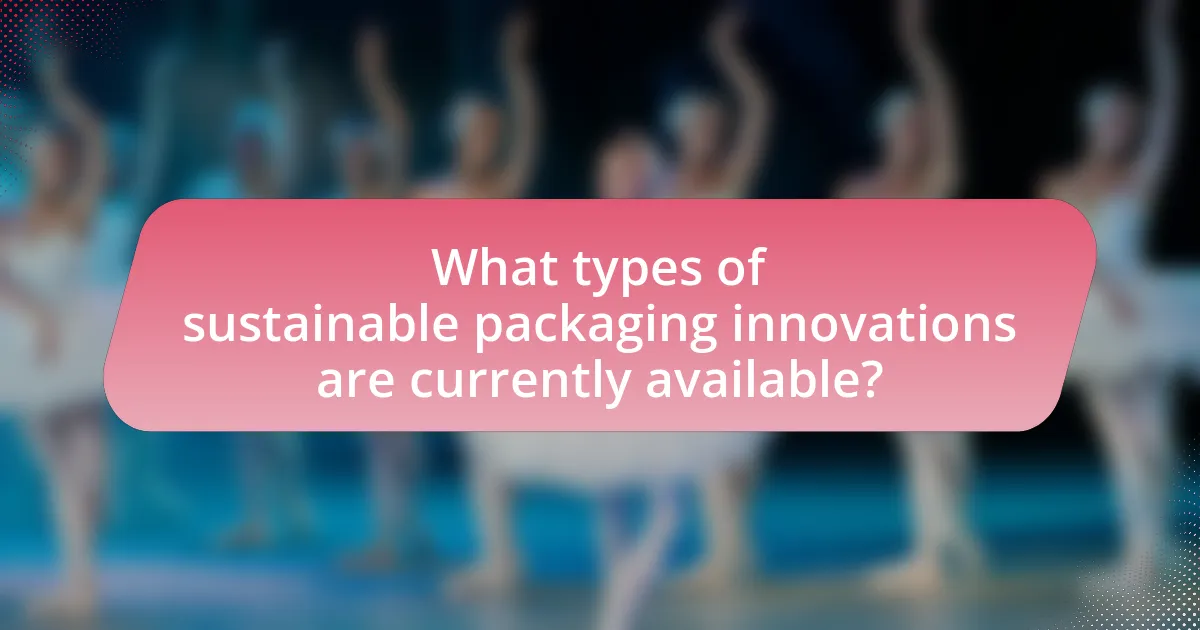
What types of sustainable packaging innovations are currently available?
Sustainable packaging innovations currently available include biodegradable materials, compostable packaging, and reusable containers. Biodegradable materials, such as polylactic acid (PLA) derived from corn starch, break down naturally over time, reducing landfill waste. Compostable packaging, like those made from plant-based fibers, can decompose in industrial composting facilities, returning nutrients to the soil. Reusable containers, often made from durable materials like glass or stainless steel, minimize single-use packaging and encourage a circular economy. These innovations are supported by the growing demand for eco-friendly solutions in the agricultural sector, as evidenced by a report from Smithers Pira, which indicates that the sustainable packaging market is projected to reach $500 billion by 2027.
What materials are being used in sustainable packaging?
Sustainable packaging primarily utilizes materials such as biodegradable plastics, recycled paper, plant-based materials, and compostable films. Biodegradable plastics, derived from renewable resources like corn starch, break down more easily in the environment compared to traditional plastics. Recycled paper reduces the need for virgin materials and minimizes waste. Plant-based materials, including bamboo and sugarcane, offer renewable alternatives that can replace conventional packaging. Compostable films, made from materials like polylactic acid (PLA), decompose in composting environments, contributing to a circular economy. These materials collectively support environmental sustainability by reducing waste and reliance on fossil fuels.
How do biodegradable materials compare to traditional plastics?
Biodegradable materials decompose naturally and reduce environmental impact, while traditional plastics persist in the environment for hundreds of years. Biodegradable materials, such as polylactic acid (PLA) and polyhydroxyalkanoates (PHA), break down into natural substances like water, carbon dioxide, and biomass within a few months to a few years under appropriate conditions. In contrast, traditional plastics, primarily derived from fossil fuels, contribute to pollution and harm wildlife due to their durability and resistance to degradation. Research indicates that approximately 8 million tons of plastic waste enter oceans annually, exacerbating environmental issues. Thus, biodegradable materials offer a more sustainable alternative to traditional plastics in packaging, particularly in agricultural applications where reducing waste is crucial.
What role do renewable resources play in sustainable packaging?
Renewable resources are essential in sustainable packaging as they reduce reliance on fossil fuels and minimize environmental impact. By utilizing materials such as plant-based plastics, paper, and biodegradable substances, sustainable packaging can be produced with a lower carbon footprint. For instance, according to a study published in the Journal of Cleaner Production, packaging made from renewable resources can decrease greenhouse gas emissions by up to 50% compared to traditional petroleum-based packaging. This shift not only conserves natural resources but also promotes a circular economy, where materials can be reused or composted, further enhancing sustainability in agricultural product packaging.
What technologies are driving innovations in sustainable packaging?
Biodegradable materials and smart packaging technologies are driving innovations in sustainable packaging. Biodegradable materials, such as polylactic acid (PLA) and other plant-based polymers, decompose naturally, reducing landfill waste. Smart packaging technologies, which include sensors and indicators, enhance product freshness and reduce spoilage, thereby minimizing food waste. According to a report by Smithers Pira, the global market for sustainable packaging is expected to reach $500 billion by 2027, highlighting the significant impact of these technologies on the industry.
How does smart packaging enhance sustainability?
Smart packaging enhances sustainability by utilizing advanced technologies to reduce waste and improve resource efficiency. For instance, smart packaging can include sensors that monitor the freshness of agricultural products, thereby minimizing spoilage and ensuring that only high-quality items reach consumers. This technology can lead to a significant reduction in food waste, which accounts for approximately one-third of all food produced globally, according to the Food and Agriculture Organization. Additionally, smart packaging often employs recyclable or biodegradable materials, further decreasing environmental impact and promoting a circular economy.
What advancements in production processes contribute to sustainability?
Advancements in production processes that contribute to sustainability include the adoption of biodegradable materials, energy-efficient manufacturing techniques, and the implementation of circular economy principles. Biodegradable materials, such as plant-based plastics, reduce environmental impact by breaking down naturally, thus minimizing landfill waste. Energy-efficient manufacturing techniques, like using renewable energy sources and optimizing machinery, significantly lower carbon emissions; for instance, companies that switch to solar power can reduce their energy costs by up to 75%. Circular economy principles, which emphasize recycling and reusing materials, help in reducing resource consumption and waste generation, as evidenced by the fact that recycling one ton of plastic can save up to 7.4 cubic yards of landfill space. These advancements collectively enhance sustainability in production processes.
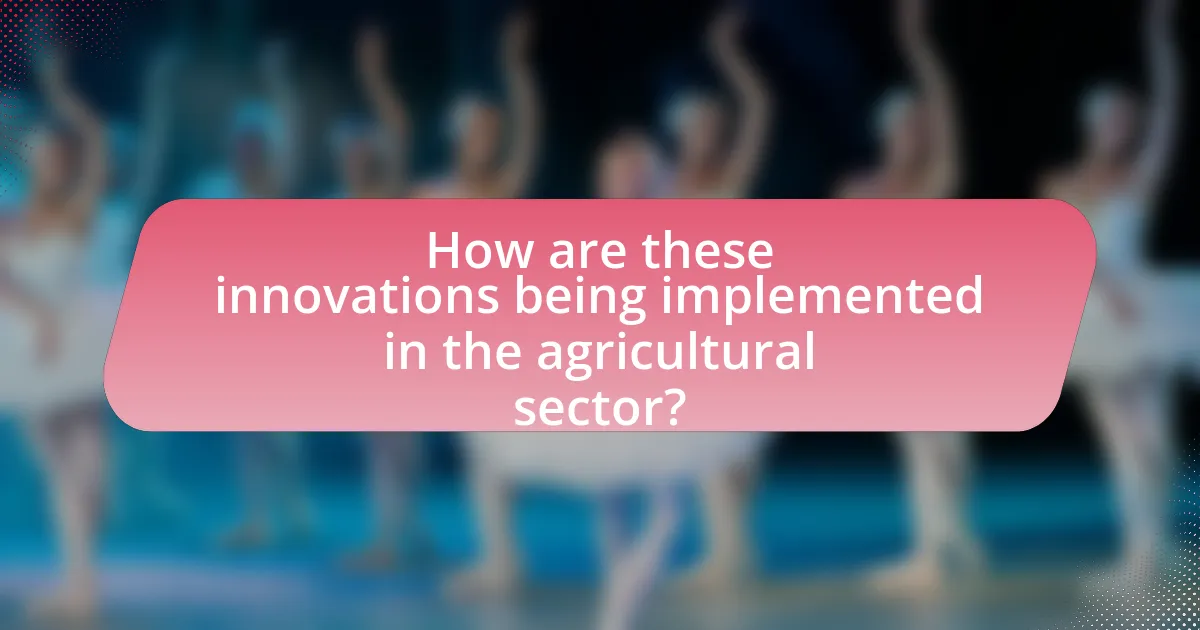
How are these innovations being implemented in the agricultural sector?
Innovations in sustainable packaging for agricultural products are being implemented through the adoption of biodegradable materials, smart packaging technologies, and reduced plastic usage. Biodegradable materials, such as plant-based plastics and compostable films, are increasingly used to replace traditional plastic packaging, thereby minimizing environmental impact. Smart packaging technologies, which include sensors that monitor freshness and quality, are being integrated to enhance supply chain efficiency and reduce food waste. Additionally, many agricultural producers are actively reducing plastic usage by opting for recyclable or reusable packaging solutions, aligning with sustainability goals. For instance, a report by the Food and Agriculture Organization highlights that the shift towards sustainable packaging can significantly decrease the carbon footprint associated with agricultural products, demonstrating the effectiveness of these innovations in practice.
What are the challenges faced during the adoption of sustainable packaging?
The challenges faced during the adoption of sustainable packaging include high costs, limited availability of materials, and consumer acceptance issues. High costs arise from the production and sourcing of eco-friendly materials, which can be more expensive than traditional packaging options. Limited availability of sustainable materials can hinder manufacturers’ ability to switch to greener alternatives, as not all regions have access to these resources. Additionally, consumer acceptance issues may occur if customers are not educated about the benefits of sustainable packaging or if they perceive it as less effective than conventional packaging. These challenges can impede the widespread implementation of sustainable packaging solutions in the agricultural sector.
How can agricultural businesses overcome these challenges?
Agricultural businesses can overcome challenges in sustainable packaging by adopting innovative materials and technologies that reduce environmental impact. For instance, utilizing biodegradable plastics made from renewable resources can significantly decrease waste and pollution associated with traditional packaging. Research indicates that the global biodegradable plastics market is projected to reach $6.9 billion by 2025, highlighting a growing trend towards sustainable alternatives. Additionally, implementing smart packaging solutions, such as those that monitor freshness and reduce spoilage, can enhance product quality and reduce losses. By investing in these innovations, agricultural businesses can not only meet consumer demand for sustainability but also improve their operational efficiency and profitability.
What role do regulations play in the adoption of sustainable packaging?
Regulations significantly influence the adoption of sustainable packaging by establishing mandatory standards and guidelines that companies must follow. These regulations often promote the use of environmentally friendly materials, limit the use of harmful substances, and encourage recycling and composting practices. For instance, the European Union’s Single-Use Plastics Directive aims to reduce plastic waste by banning certain single-use plastic items and promoting alternatives, thereby driving companies to innovate and adopt sustainable packaging solutions. Compliance with such regulations not only helps businesses avoid penalties but also enhances their brand reputation among environmentally conscious consumers, ultimately accelerating the transition to sustainable packaging in the agricultural sector.
What are some successful case studies of sustainable packaging in agriculture?
Successful case studies of sustainable packaging in agriculture include the use of biodegradable films by companies like BioBag and the implementation of reusable packaging systems by Loop. BioBag produces compostable bags made from plant materials, which have been adopted by various agricultural producers to reduce plastic waste. Loop, on the other hand, collaborates with farmers to create a circular economy for packaging, allowing for the return and reuse of containers, thereby minimizing single-use plastic. These initiatives demonstrate effective strategies for reducing environmental impact while maintaining product integrity in the agricultural sector.
How have specific companies benefited from adopting sustainable packaging?
Specific companies have benefited from adopting sustainable packaging by enhancing their brand reputation and increasing customer loyalty. For instance, Unilever reported that its sustainable product lines grew 69% faster than the rest of its business, demonstrating a clear market preference for environmentally friendly options. Additionally, Coca-Cola has committed to using 50% recycled content in its packaging by 2030, which not only reduces environmental impact but also appeals to consumers who prioritize sustainability, leading to increased sales. These examples illustrate how adopting sustainable packaging can drive financial performance and strengthen market position.
What lessons can be learned from these case studies?
The lessons learned from case studies on innovations in sustainable packaging for agricultural products include the importance of material selection, the effectiveness of biodegradable options, and the role of consumer education. Material selection is crucial as it directly impacts the environmental footprint; for instance, using plant-based plastics can significantly reduce reliance on fossil fuels. Biodegradable packaging has shown to decrease waste in landfills, as evidenced by studies indicating that such materials can decompose within months under the right conditions. Additionally, consumer education is vital; case studies reveal that informed consumers are more likely to choose sustainable options, leading to increased demand for eco-friendly packaging solutions.
What best practices should agricultural businesses follow when adopting sustainable packaging?
Agricultural businesses should prioritize using biodegradable materials, optimizing packaging design for minimal waste, and ensuring recyclability when adopting sustainable packaging. Biodegradable materials, such as plant-based plastics, decompose naturally, reducing landfill impact. Optimizing packaging design involves creating smaller, more efficient packages that use fewer resources and reduce transportation emissions. Ensuring recyclability means selecting materials that can be easily processed in existing recycling systems, promoting a circular economy. According to a report by the Ellen MacArthur Foundation, transitioning to sustainable packaging can significantly reduce environmental footprints, highlighting the importance of these best practices in the agricultural sector.










